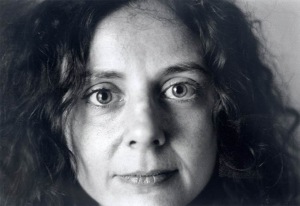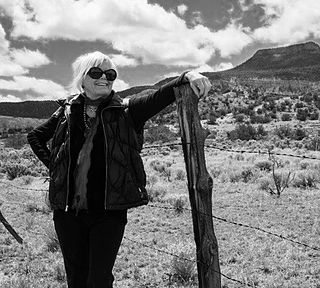Related Research Articles
Video art is an art form which relies on using video technology as a visual and audio medium. Video art emerged during the late 1960s as new consumer video technology such as video tape recorders became available outside corporate broadcasting. Video art can take many forms: recordings that are broadcast; installations viewed in galleries or museums; works streamed online, distributed as video tapes, or DVDs; and performances which may incorporate one or more television sets, video monitors, and projections, displaying live or recorded images and sounds.
Sarah Lucas is an English artist. She is part of the generation of Young British Artists who emerged in 1988. Her works frequently employ visual puns and bawdy humour by incorporating photography, sculpture, collage and found objects.
Dame Sonia Dawn Boyce is a British Afro-Caribbean artist and educator, living and working in London. She is a Professor of Black Art and Design at University of the Arts London. Boyce's research interests explore art as a social practice and the critical and contextual debates that arise from this area of study. Boyce has been closely collaborating with other artists since 1990 with a focus on collaborative work, frequently involving improvisation and unplanned performative actions on the part of her collaborators. Boyce's work involves a variety of media, such as drawing, print, photography, video, and sound. Her art explores "the relationship between sound and memory, the dynamics of space, and incorporating the spectator". To date, Boyce has taught Fine Art studio practice for more than 30 years in several art colleges across the UK.

Isa Genzken is a German artist who lives and works in Berlin. Her primary media are sculpture and installation, using a wide variety of materials, including concrete, plaster, wood and textile. She also works with photography, video, film and collage.

Carol Bove is an American artist based in New York City. She lives and works in Brooklyn.

Lynda Benglis is an American sculptor and visual artist known especially for her wax paintings and poured latex sculptures. She maintains residences in New York City, Santa Fe, New Mexico, Kastellorizo, Greece, and Ahmedabad, India.
Marilyn Minter is an American visual artist who is perhaps best known for her sensual paintings and photographs done in the photorealism style that blur the line between commercial and fine art. Minter currently teaches in the MFA department at the School of Visual Arts in New York City.

Belkis Ayón was a Cuban printmaker who specialized in the technique of collography. Ayón created large, highly detailed allegorical collagraphs based on Abakuá, a secret, all-male Afro-Cuban society. Her work is often in black and white, consisting of ghost-white figures with oblong heads and empty, almond-shaped eyes, set against dark, patterned backgrounds.
Collier Schorr is an American artist and fashion photographer best known for adolescent portraits that blend photographic realism with elements of fiction and youthful fantasy.

Lee Lozano was an American painter, and visual and conceptual artist.
Mika Rottenberg is a contemporary Argentine-Israeli video artist who lives and works in New York City. Rottenberg is best known for her surreal video and installation work that often "investigates the link between the female body and production mechanisms". Her work has been exhibited both nationally and internationally.

Frances Stark is an interdisciplinary artist and writer, whose work centers on the use and meaning of language, and the translation of this process into the creative act. She often works with carbon paper to hand-trace letters, words, and sentences from classic works by Emily Dickinson, Goethe, Henry Miller, Samuel Beckett, and others to explore the voices and interior states of writers. She uses these hand-traced words, often in repetition, as visual motifs in drawings and mixed media works that reference a subject, mood, or another discipline such as music, architecture, or philosophy.

Simone Leigh is an American artist from Chicago who works in New York City in the United States. She works in various media including sculpture, installations, video, performance, and social practice. Leigh has described her work as auto-ethnographic, and her interests include African art and vernacular objects, performance, and feminism. Her work is concerned with the marginalization of women of color and reframes their experience as central to society. Leigh has often said that her work is focused on “Black female subjectivity,” with an interest in complex interplays between various strands of history. She was named one of the 100 most influential people in the world by Time magazine in 2023.

Melissa Miller is an American painter who is best known for what Art in America called "raucous allegorical paintings" of animals that balance storytelling, psychological insight and behavioral observation with technical virtuosity and formal rigor. She rose to prominence during a rebirth in figurative painting and narrative content in the early 1980s championed by curators such as Marcia Tucker and Barbara Rose, who both selected Miller for prominent surveys. Rose identified Miller among a group of iconoclastic "rule breakers," describing her work as "a wild kingdom … gone slightly berserk" in the struggle for survival, whose intensity recalled Delacroix. In a later Artforum review, Donald Kuspit called Miller's paintings "apocalyptic allegories" executed with meticulous old-master methods that articulated psychic states, existential problems and ecological concerns. Miller has exhibited at museums throughout the United States, including the Whitney Museum, New Museum, San Francisco Museum of Modern Art (SFMOMA), Museum of Fine Arts, Houston, and Hirshhorn Museum. Her work belongs to the public art collections of the Museum of Modern Art, National Museum of Women in the Arts, Albright-Knox Gallery and Museum of Fine Arts, Houston, among others, and she has received the Anonymous Was A Woman Award and Texas Artist of the Year Award. Miller lives and works in Austin, Texas.

Harry Dodge is an American sculptor, performer, video artist, professor, and writer.

Cheryl Marie Bowers, known as Ciel Bergman, was an American painter of Swedish origin. Her work, considered post-modern, has a focus on the environment as well as feminine consciousness.
Leonor Antunes is a Portuguese contemporary artist who creates sculptural installations. She lives and works in Berlin.
Dineo Seshee Bopape is a South African multimedia artist. Using experimental video montages, sound, found objects, photographs and dense sculptural installations, her artwork "engages with powerful socio-political notions of memory, narration and representation." Among other venues, Bopape's work has been shown at the New Museum, the Institute of Contemporary Art, Philadelphia, and the 12th Biennale de Lyon. Solo exhibitions of her work have been mounted at Mart House Gallery, Amsterdam; Kwazulu Natal Society of Arts, Durban; and Palais de Tokyo. Her work in the collection of the Tate.

Cheryl Laemmle is an American contemporary surrealist painter of figures, animals, and imaginary landscapes.

Melati Suryodarmo is an Indonesian durational performance artist. Her physically demanding performances make use of repetitive motions and often last for many hours, sometimes reaching "a level of factual absurdity". Suryodarmo has performed and exhibited throughout Europe and Asia as well as in North America. Born in Surakarta, she attended Padjadjaran University, graduating with a degree in international relations before moving to Germany. She lived there for 20 years, studying performance art at the Braunschweig University of Art with Butoh choreographer Anzu Furukawa and performance artist Marina Abramović.
References
- 1 2 3 4 "LECTURE, PERFORMANCE, AND DISCUSSION: CHERYL DONEGAN" Archived 2017-08-19 at the Wayback Machine , at Contemporary Arts Museum Houston website (retrieved January 24, 2014)
- 1 2 3 "Cheryl Donegan" at the Artnet
- 1 2 3 "Cheryl Donegan at Basilico Fine Arts", by Robert Mahoney (retrieved January 24, 2014)
- ↑ "Cheryl Donegan: Biography". Electronic Arts Intermix. Archived from the original on May 29, 2015. Retrieved January 20, 2014.
- 1 2 3 4 5 6 7 Darke, Chris (2000). Light Readings: Film Criticism and Screen Arts. London: Wallflower. pp. 171–172. ISBN 9781903364079.
- ↑ Collier Schorr, "Cheryl Donegan", Artforum International , Vol. 31, No. 10 (retrieved January 24, 2014)
- ↑ "Head". MoMA. The Museum of Modern Art, New York. Retrieved 24 January 2014.
- ↑ Urbaschek, Stephan (2003). "Cheryl Donegan". In Goetz, Ingvild; Urbaschek, Stephan (eds.). Fast forward. Translated by Lisa Rosenblatt. Distributed Art Pub Incorporated. p. 517. ISBN 978-3-9808063-9-8.
- 1 2 3 4 5 Schorr, Collier (Summer 1993). "Cheryl Donegan". Artforum International . 31 (10): 96.[ dead link ]
- ↑ Wolf, Jonah (February 2013). "The Dream of the '90s Is Alive at the New Museum". Paper . Archived from the original on January 19, 2014. Retrieved January 17, 2014.
Some works manage to be funny and sexy as they challenge the viewer's gaze, daring you to judge them. Cheryl Donegan's Head depicts the artist lapping up milk to the tune of Sugar's "A Good Idea."
- 1 2 Jones, Amelia. "Feminist Performance Art". Encyclopedia of Aesthetics. Oxford Art Online . Oxford University Press . Retrieved January 20, 2014.
 (Subscription required.)
(Subscription required.) - ↑ Bénézit, Emmanuel (2006). "Donegan, Cheryl". Benezit Dictionary of Artists . Vol. 4. Oxford University Press.
 (Subscription required.)
(Subscription required.) - ↑ "Cheryl Donegan CV". Sgorbati Projects.